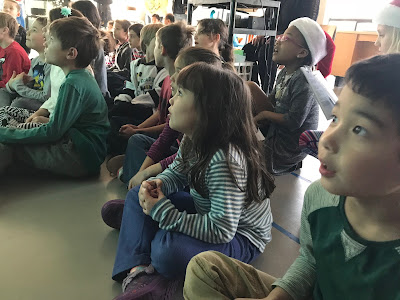He started out by asking us a simple question: "What are your impressions of the Middle Ages?"
Our answers were varied and quite knowledgeable for first and second graders:
- harsh
- feudal
- hard labor
- gory-bloody disputes
- war and knights
- serfs built their houses out of twigs and stuff
- peasants were poor, too, but they could build better houses
- the plague killed a lot of people and it was very sad
- books were hand written and cost a lot
- the nobles lived in castles
- the kings had most of the money
Jacob was quite taken aback and said, "You are prodigious! I wasn't expecting this at all!"
He then began, in his gentle, captivating way, to share more about the Middle Ages. Such an enriching way to continue our own life-long studies of the world around us!
The "Horse's Bransle" Dance:
Big to the left, big to the left
Small to the right, small to the right
Paw your foot like a horse
And kick, kick, kick, kick
Clothing: notice the layers, the hood (a separate article of clothing,) the woven belt (woven by Jacob himself,) hand made shoes (that are in need of a cobbler,) and even a hole in his sock.
Also notice the tippits hanging down on his arms, and the handwoven, linen underwear that should last for over 100 years!
One student said, "Your outfit looks like a shield!"
Keen observation.
When Jacob was younger, he worked as a paper boy to buy Medieval instruments. But some of them were way too expensive to buy. So he learned how to make them!
He played a variety of hand-crafted instruments
from the recorder family.
This is a double reed wind cap Krumhorn, one of several from this family of instruments that Jacob brought.
"It sounds like the sound track from Mario."
"The bigger one sounds electronic."
"It's like a bassoon."
Jacob also played the viola da gamba,
a Renaissance instrument similar to a cello.
Click here to hear his song.
Its name is Licky the Lion, named after the beautifully carved lion head (in the place of a scroll) with its tongue sticking out.
And finally, to answer the question, "What is a hurdy-gurdy?!"
"The hurdy-gurdy is a stringed instrument that produces sound by a hand crank-turned, rosined wheel rubbing against the strings. The wheel functions much like a violin bow, and single notes played on the instrument sound similar to those of a violin." ~Wikipedia
Jacob playing a 700 year old French dance song on his hand-crafted hurdy-gurdy.
The kids' reactions:
- "Wow!"
- "It sounds like a fog horn."
- "I felt like I was in the Middle Ages."
- "It was really beautiful."
- "Magic."
- "Calm, soothing"
- "Mesmerizing."
We learn something new each day, including this teacher!
Can't wait to start studying the Renaissance time period!
Thank you, Jacob, for sharing one of your many passions with us.
Check him out here for more information about him.





















































